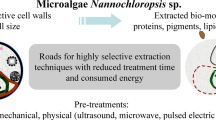Abstract
The microalga Porphyridium cruentum is known to produce many components of interest. One of them is B-Phycoerythrin (B-PE), a water-soluble intracellular pigment used as an immunofluorescent probe. Current methods to extract this molecule involve total cell disruption and lead to a mix of all the water-soluble components. Subsequently, the pigment purification is very complex. An alternative approach to extract B-PE selectively and thus simplify the purification procedure has been developed using a high-pressure cell disrupter. Different pressures (from 27 to 270 MPa), extracting mediums (distilled water and original microalgae culture medium), and numbers of passages (1 to 3) have been tested. Proteins are selectively more extracted than B-PE at low pressure in original medium. It is thus possible to remove part of the intracellular proteins in a first step and then recover enriched B-Phycoerythrin fraction at higher pressure in distilled water.





Similar content being viewed by others
References
Aitken A, Learmonth M (1996) Protein determination by UV absorption. In: Walker JM (ed) The protein protocols handbook. Humana Press, Totowa, pp 3–6
Anand H, Balasundaram B, Pandit A, Harrison S (2007) The effect of chemical pretreatment combined with mechanical disruption on the extent of disruption and release of intracellular protein from E. coli. Biochem Engg J 35:166–173
Arad S, Yaron A (1992) Natural pigments from red microalgae for use in foods and cosmetics. Trends Food Sci Tech 3:92–97
Arad S, Adda M, Cohen E (1985a) The potential of production of sulfated polysaccharides from Porphyridium. Plant Soil 89:117–127
Arad S, Adda M, Merchuk JC (1985b) Potential for production of polysaccharides from the unicellular red alga Porphyridium. Abstr Pap Amer Chem Soc 190(SEP):171, MBD
Arad S, Friedman O, Rotem A (1988) Effect of nitrogen on polysaccharide production in a Porphyridium sp. Appli Env Microbiol 54:2411–2414
Arakawa T, Timasheff SN (1985) Theory of protein solubility. Methods Enzymol 114:49–77
Balasundaram B, Harrison STL (2006) Disruption of brewers’ yeast by hydrodynamic cavitation: process variables and their influence on selective release. Biotechnol Bioeng 94:303–311
Balasundaram B, Pandit AB (2001) Selective release of invertase by hydrodynamic cavitation. Biochem Eng J 8:251–256
Benavides J, Rito Palomares M (2004) Bioprocess intensification: a potential aqueous two-phase process for the primary recovery of B-phycoerythrin from Porphyridium cruentum. J Chromatog B 807:33–38
Benavides J, Rito Palomares M (2006) Simplified two-stage method to B-phycoerythrin recovery from Porphyridium cruentum. J Chromatog B 844:39–44
Bermejo Roman R, Alvarez-Pez JM, Acien Fernandez FG, Molina Grima E (2002) Recovery of pure B-phycoerythrin from the microalga Porphyridium cruentum. J Biotech 93:73–85
Bermejo R, Talavera EM, Alvarez-Pez JM (2001) Chromatographic purification and characterization of B-phycoerythrin from Porphyridium cruentum. Semipreparative high-performance liquid chromatographic separation and characterization of its subunits. J Chromatog A 917:135–145
Bermejo R, Acien FG, Ibanez M, Fernandez J, Molina E, Alvarezpez J (2003) Preparative purification of B-phycoerythrin from the microalga Porphyridium cruentum by expanded-bed adsorption chromatography. J Chromatog B 790:317–325
Brody M, Vatter AE (1959) Observations on cellular structures of Porphyridium cruentum. J Biophys Biochem Cytol 5:289–300
Chisti Y, Moo-Yong M (1986) Disruption of microbial cells for intracellular products. Enzyme Microb Technol 8:194–204
Collins S, Attouche C, Yau C, Jones M, Lovitt R (1996) An investigation of microorganisms using a new type of cell homogenizer. IchemE Research Event/Second European Conference for Young Researchers:52–54
Csogör Z, Kiessling B, Perner I, Fleck P, Posten C (2001) Growth and product formation of Porphyridium purpureum. J Appl Phycol 13:317–324
Gantt E, Conti SF (1965) The ultrastructure of Porphyridium cruentum. J Cell Biol 26:364–381
Geciova J, Bury D, Jelen P (2002) Methods for disruption of microbial cells for potential use in the dairy industry—a review. Inte Dairy J 12:541–553
Halim R, Harun R, Danquah MK, Webley PA (2012) Microalgal cell disruption for biofuel development. Appl Energy 91:116–121
Hemerick G (1973) Culture methods and growth measurements. In: Stein JR (ed) Handbook of phycological methods. Cambridge University Press, New York, pp 259–260
Jones RF, Kury W, Speer HL (1963) Studies on growth of red alga Porphyridium cruentum. Physiol Plant 16:636–643
Klotz B, Mañas P, Mackey BM (2010) The relationship between membrane damage, release of protein and loss of viability in Escherichia coli exposed to high hydrostatic pressure. Int J Food Microbiol 137:214–220
Kronick MN (1986) The use of phycobiliproteins as fluorescent labels in immunoassay. J Immunol Meth 92:1–13
Loubiere K, Pruvost J, Aloui F, Legrand J (2011) Investigations in an external-loop airlift photobioreactor with annular light chambers and swirling flow. Chem Eng Rese Design 89:164–171
Lovitt RW, Jones M, Collins SE, Coss GM, Yau CP, Attouch C (2000) Disruption of bakers’ yeast using a disrupter of simple and novel geometry. Process Biochemiy 36:415–421
Middelberg APJ (1995) Process-scale disruption of microorganisms. Biotech Advs 13:491–551
Ramus J (1972) Production of extracellular polysaccharide by unicellular red alga Porphyridium aerugineum. J Phycol 8:97–111
Rice NM, Irving H, Leonard MA (1993) Nomenclature for liquid-liquid distribution (solvent-extraction) (IUPAC recommendations 1993). Pure Appl Chem 65:2373–2396
Rito Palomares MA, Benavides Lozano JA, Hernandez Mireles TD (2008) Recovery and purification of B-phycoerythrin produced by Porphyridium cruentum using two-aqueous-phase systems and isoelectric precipitation. US Patent 8178321
Rossignol N, Moan R, Jaouen P, Robert JM, Quemeneur F (1999) Continuous high-pressure disruption of marine diatom Haslea ostrearia. Assessment by laser diffraction particle sizer. Biotechnol Techniq 13:909–913
Shynkaryk MV, Lebovka NI, Lanoisellé JL, Nonus M, Bedel-Clotour C, Vorobiev E (2009) Electrically-assisted extraction of bio-products using high pressure disruption of yeast cells (Saccharomyces cerevisiae). J Food Eng 92:189–195
Acknowledgments
This study was supported by the French National Research Agency (ANR) in the framework of the “Algoraffinerie” program. This involves three French laboratories, namely, GEPEA (Nantes University), LCA (Toulouse University), LGCB (Clermont-Ferrand University), and a start-up, Algosource Technologies.
Author information
Authors and Affiliations
Corresponding author
Rights and permissions
About this article
Cite this article
Jubeau, S., Marchal, L., Pruvost, J. et al. High pressure disruption: a two-step treatment for selective extraction of intracellular components from the microalga Porphyridium cruentum . J Appl Phycol 25, 983–989 (2013). https://doi.org/10.1007/s10811-012-9910-5
Received:
Revised:
Accepted:
Published:
Issue Date:
DOI: https://doi.org/10.1007/s10811-012-9910-5




